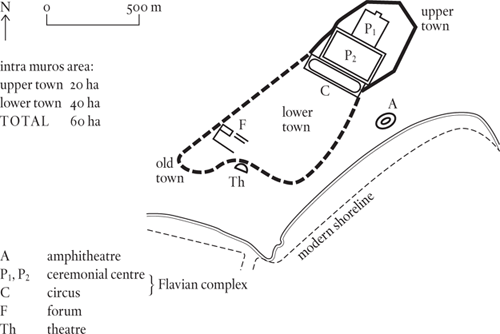
Tarragona province, Spain
Classical Tarraco; capital of the Roman province of Tarraconensis
At the start of the Second Punic War (218 BC) the Romans made Tarragona the base for their operations in the Iberian peninsula. Fortifications on the high ground to the north-east of the native settlement belong to this period; this ‘upper town’ became the administrative centre for Near Spain some time after the two provinces of Near and Far Spain were set up at the end of the war. Its status as a provincial capital was confirmed in 26 BC when Augustus divided Spain into three; the sector centred on Tarraco subsequently became known as Tarraconensis.
Augustus, who resided in Tarraco in 26–25 BC, gave the city a new plan, centred on the previously undeveloped zone between upper (Roman) and old (native) towns. This ‘lower town’ was given an orthogonal street grid (we think) and certainly a forum and theatre; it soon became the main focus in the urban life of Tarraco, leaving the upper city free for a grandiose rebuilding programme that, under the Flavian emperors (AD 69–96), turned this area into a purely ceremonial centre. Presumably this was intended to provide a dignified background for meetings of the provincial assembly. The second century AD saw the construction of an amphitheatre to the south of the upper town, near the seafront.
In AD 260, a crisis year for the empire, a band of Franks who had been pillaging their way through Gaul reached across the Pyrenees and put Tarraco to the sack. The damage seems to have been limited: Tarraco remained the provincial capital, and there are notices of continuing building work under the Tetrarchy (a ‘Porticus Ioviae’) and the Constantinians (restorations of the circus and baths). But Tarraco’s area of responsibility had been reduced (by Maximian, who split Tarraconensis into three in 297) and its prosperity was now on the ebb. By the fifth century the signs of decline are obvious: the lower town had been abandoned, and in the upper town – all that remained of classical Tarragona – a huddle of poor houses occupied the remains of the grandiose structures erected under the Flavians. Its metropolitan status was increasingly usurped by Barcelona, a small place, but one whose star was rising as Tarragona’s fell.

In Visigothic hands since 476, Tarragona was finally destroyed by Arab raiders in 713–14. It was refounded after the Christian recovery of the area in the twelfth century, and most of the Roman town lies beneath the modern city. The most visible remains are those of the amphitheatre and some stretches of the walls of the upper town. There are as yet no traces of the walls of the lower town, which means that the proposed intramural area for Tarragona of about sixty hectares (upper town a bit under twenty hectares, lower town a bit over forty) is only a hypothesis.
It is unlikely that Roman Tarragona ever had a population greater than the 4,000 recorded for the town in the sixteenth and seventeenth centuries.